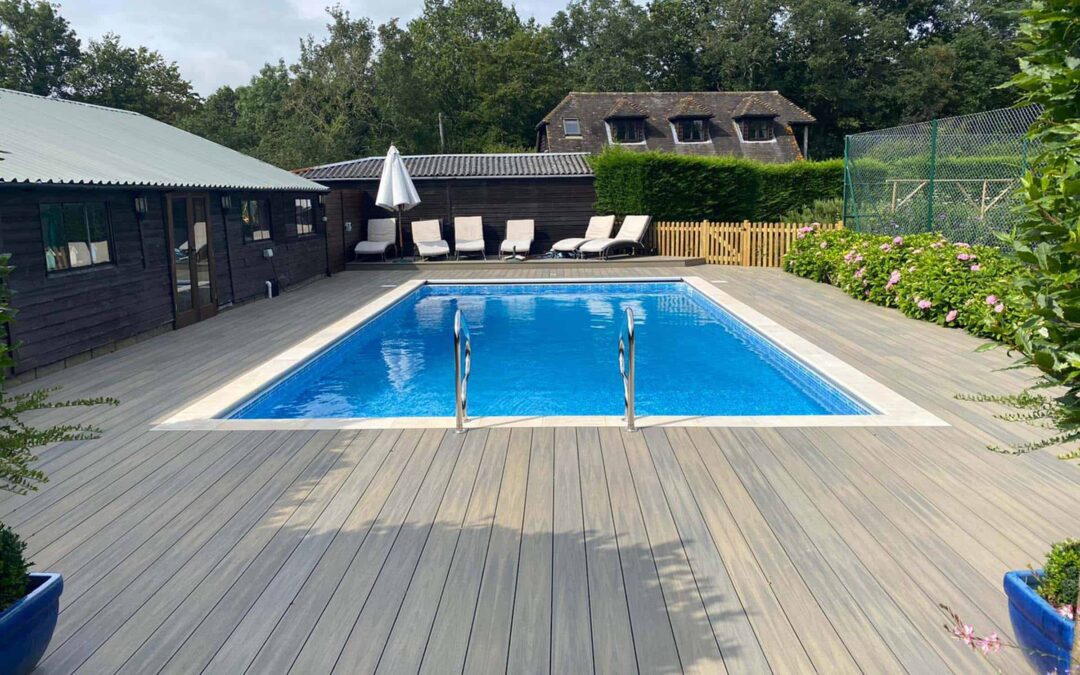A well-designed pool deck is not just an accessory; it’s a fundamental element that transforms a swimming pool into a luxurious retreat. Whether you’re building a new pool or renovating an existing one, the choice of pool decking can significantly impact the overall aesthetics, safety, and functionality of your outdoor space. In this comprehensive guide, we’ll explore various types of pool decks, their advantages, design considerations, and maintenance tips to help you create the perfect poolside oasis.
Types of Pool Decking Materials:
- Concrete:
Concrete pool decks are popular for their versatility and durability. They can be poured in various shapes and sizes, allowing for customizable designs. Additionally, concrete can be stamped, stained, or textured to mimic the appearance of natural stone or pavers, providing a cost-effective alternative.
- Natural Stone:
Natural stone, such as travertine, limestone, or flagstone, creates a timeless and elegant look for pool decks. The inherent variations in color and texture add a touch of sophistication to the outdoor space. While natural stone can be more expensive, its durability and aesthetic appeal make it a favorite among homeowners looking for a luxurious pool deck.
- Wood:
Wooden pool decks exude warmth and bring a touch of nature to your poolside oasis. Common wood choices include cedar, redwood, and tropical hardwoods like ipe. Wood provides a comfortable and natural surface underfoot. However, it requires regular maintenance to prevent issues like splintering, warping, and decay.
- Composite Decking:
Composite decking is a low-maintenance alternative to traditional wood. Made from a combination of wood fibers and recycled plastic, composite materials offer the appearance of wood without the drawbacks. They resist fading, staining, and are less prone to rot, making them an excellent choice for those seeking a balance between aesthetics and durability.
- Pavers:
Pavers, often made of concrete, brick, or stone, are individual units that interlock to create a pool deck. They come in various shapes, sizes, and colors, allowing for endless design possibilities. Pavers are known for their ease of installation, durability, and resistance to cracking, making them a practical and visually appealing option.
Design Considerations:
- Safety:
Safety is paramount when designing a pool deck. Choose materials with slip-resistant surfaces to reduce the risk of accidents, especially in wet conditions. Textured finishes or pavers with naturally rough surfaces can enhance traction and provide a secure environment.
- Heat Reflectivity:
The heat reflectivity of the pool decking material is crucial, especially in sunny climates. Light-colored materials tend to reflect heat, keeping the surface cooler for bare feet. Consider this factor to ensure that your pool deck remains comfortable even on scorching summer days.
- Aesthetic Appeal:
The aesthetics of your pool deck contribute significantly to the overall ambiance of your outdoor space. Consider the architectural style of your home, the surrounding landscape, and your personal preferences when selecting materials and designs. Complementing the pool deck with the overall theme of your outdoor area creates a harmonious and visually pleasing environment.
- Comfort and Functionality:
Comfort is key when designing a pool deck. Choose materials that remain cool to the touch, even under the hot sun. Additionally, consider incorporating shaded areas, such as pergolas or umbrellas, to provide relief from the sun. Functionality is equally important – ensure there’s ample space for lounging, dining, and other outdoor activities.
- Maintenance Requirements:
Different materials have varying maintenance needs. Concrete may require occasional resealing, wood needs regular staining and sealing, while pavers may need periodic cleaning. Consider your willingness to invest time and effort into maintenance when selecting the pool decking material.
Pool Deck Maintenance Tips:
- Regular Cleaning:
Keep your pool deck free from debris, leaves, and other organic materials. Regular sweeping or blowing helps prevent stains and deterioration.
- Sealing and Staining:
Depending on the material, consider applying sealant or stain to protect the pool deck from UV rays, water damage, and other environmental factors. This helps maintain the deck’s appearance and structural integrity.
- Repairing Cracks:
Address any cracks or damages promptly to prevent them from worsening. Fill cracks with an appropriate filler material and consider resurfacing if necessary.
- Pressure Washing:
Periodically pressure wash your pool deck to remove built-up dirt, algae, and stains. This not only improves aesthetics but also prevents slippery surfaces.
- Furniture Protection:
Place protective pads under furniture to prevent scratches and dents on the pool deck surface. This is particularly important for wood and composite decking materials.
- Professional Inspections:
Schedule professional inspections, especially for materials like wood that may be prone to decay or insect damage. Early detection of issues allows for timely intervention and prevents extensive damage.
Conclusion:
A carefully chosen and well-maintained pool deck transforms your backyard into a luxurious haven, providing a seamless transition between your indoor and outdoor living spaces. Whether you opt for the classic elegance of natural stone, the versatility of concrete, the warmth of wood, or the low-maintenance appeal of composite materials, your pool deck should reflect your style, enhance safety, and withstand the test of time. By considering design principles, safety features, and maintenance requirements, you can create the perfect poolside oasis that not only complements your lifestyle but also adds significant value to your property. So, dive into the world of pool decking and embark on the journey to creating a stunning outdoor retreat for years of enjoyment.

